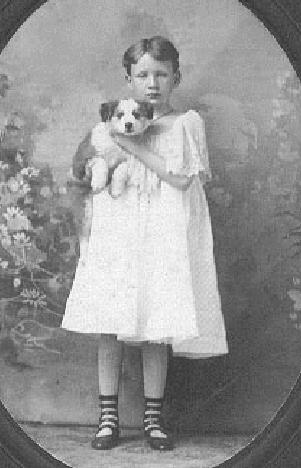
Multiple-strap Closed-toe Sandals: Conventions

Figure 1.--This American image is undated, but was probably taken in the 1900s. We thought at first that the boy was wearing a smock. An examination of the collar reveals, however, that he is not wearing a shirt, although there does seem to be a locket, and there is no indication that he is wearing kneepants. Thus we believe that this boy is wearing a dress. Also note the strap shoes that look like striped socks. A reader reports, "The boy is not wearing striped socks but a sort of multi-strapped high shoe. I have seen them before, mostly on girls but occassionally on boys. Unfortunately the image does not
show enough detail, but I think you can make out the fasteners at the side, especially on the boy's right." He looks to be about 8 years old.
|
Conventions
These multiple-strap sandals appear to have been worn for both formal occssions as well as play. As a result, we note this type of footwear worn with both formal as well as casual clothing. The boy here wears these multiple-trap sandls with a sailor suit that had bloomer-kniers. Salor suits were versitile garments. A boy could wear the for both formal occassons and play. We have noted this style of foot wear worn with a wide vaiety of garments. Unfortunately many photographic images have no provinance to help us evaluae them. This is the case of the image shown here (figure 1). The boy here appears to be waring a frock. While we have no information aout the privinance, we believe that this boy is weaing a frock rather like a smock. While there is no garment to protect underneath, we beliv that his mother used the frock rather like a smock as a casual garment t home. It is interesting thar she used it as a garment for a formal portrait.
Image
This American image is undated, but was probably taken in the 1900s. We thought at first that the boy was wearing a smock. An examination of the collar reveals, however, that he is not wearing a shirt, although there does seem to be a locket, and there is no indication that he is wearing kneepants. Thus we believe that this boy is wearing a dress. Also note the strap shoes and striped socks. A reader reports, "The boy is not wearing striped socks but a sort of multi-strapped high shoe. I have seen them before, mostly on girls but occassionally on boys. Unfortunately the image does not show enough detail, but I think you can make out the fasteners at the side,
especially on the boy's right." He looks to be about 8 years old, prhaps older.
A smock is generally defined as a loose over-garment, especially one worn to protect the clothing worn under the smock. They are especially associated with protecting children's clothing at school and at play and adult's clothing at work. The smocks worn by European farm laborers in the 19th century were sometimes referred to as a smock frock. Smocks are sometimes difficult to differentiate from two related garments, dresses and pinafores. The primary difference with a dress is that smocks are worn to protect other garments worn under the smock. This is not the case of a dress. Smocks are differentiated from pinafores in that they have both backs and sleeves. The pinafore is more of an apron-like garment, often without a back or sleeves. Even so, in some languages the word apron is used for smock. While these simple rules can usually be employed to categorize garments, some times there are dresses, smocks, and pinafores that blur the differences.
Christopher Wagner

Navigate the Boys' Historical Clothing Smock-related pages:
[Return to the Multiple-strap closed-toe sandal page]
[Pinafores]
[Fauntleroy suits]
[Fauntleroy dresses]
[Sailor hats]
[Park outings]
[French page]
[Renoir page]
[School smocks]
Navigate the Boys' Historical Clothing Web Site:
[Introduction]
[Activities]
[Bibliographies]
[Biographies]
[Chronology]
[Clothing styles]
[Countries]
[Contributions]
[FAQs]
[Glossaries]
[Satellite sites]
[Tools]
[Boys' Clothing Home]
Created: May 11, 2002
Last updated: May 11, 2002



